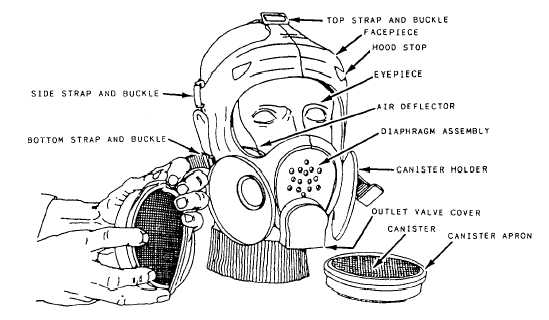Figure 6-2.-The ND Mk V
sensory effects, such as a continuous flow of tears,
might indicate that replacement is needed.
Two types of protective masks have been in
general use in the Navy: the M17A1, issued to
shore-based personnel, and the ND Mark (Mk)
V, issued to forces afloat. Both of these, however,
are being phased out and replaced by the
MCU-2/P mask. All masks consist of a facepiece
and filter system. The facepiece provides a
gastight seal around the face, protecting the eyes,
lungs, and facial skin. The filter system is attached
to the facepiece; it filters out or absorbs airborne
radioactive material and BW/CW agents before
air enters the facepiece for inhalation. The main
purpose of the mask is to purify the air being
breathed by its wearer. To effectively purify the
air, the mask must meet two requirements. First,
the facepiece must fit snugly over the face to
provide a perfect seal. Second, the filter system
must prevent any contaminated material or
chemical agent from entering the mask.
ND Mk V Protective Mask
A unique design feature of the ND Mk V
protective mask makes it ideally suited for
shipboard use. A pneumatic cushion located
around the underside edge of the facepiece allows
the facepiece to conform to the wearer’s face;
therefore, an airtight seal is possible for virtually
all facial shapes. This feature permits the issue
protective mask.
of the mask in only one size and, thus, eliminates
the need for stowing and issuing various sizes of
protective masks aboard ship.
The major components of the ND Mk V pro-
tective mask are shown in figure 6-2. The mask
facepiece is made of a black, flexible rubber
compound formulated to retard the penetration
of chemical agents. The wide-vision eyepiece is
a clear, flexible, one-piece plastic lens curved to
the shape of the facepiece. Voice transmission is
permitted by a thin plastic membrane in the
diaphragm assembly. Other features of the
facepiece include the air-inlet and exhaust valves
and the canister holders. Air deflectors, located
inside the mask, create a flow of air from the
air-inlet valves across the eyepiece to reduce
fogging.
Filtration for the mask is provided by filter
canisters mounted on the two canister holders on
the facepiece. Each of these filter canisters
contains a treated paper filter and an activated
charcoal filter. The treated paper filter removes
particulate matter, and the activated charcoal
filter absorbs toxic vapors and aerosols from the
inhaled air. A rubber apron affixed to each
canister attaches the canister to the holder on the
facepiece. The rubber apron provides an airtight
seal around this connection when it is rolled over
the back of the canister holder.
6-10



